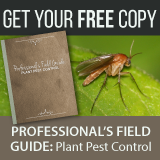

Pages: 1
| Posted: 17 Mar 2012 20:19 | |
|
Registered User Currently Offline Join Date: Jun 2011 |
Posts: 3 Reputation: Unranked User Rank: 1 - Seedling 
|
| Our rep has proposed (5) 8' Adonidia Palms for a church. I am cringing at the thought of all the spraying that's going to require. Have you hit upon something that works? We've been spraying with Crosscheck/Talstar (bifenthrin). I've searched endlessly for a systemic miticide to no avail. | |
| Posted: 17 Mar 2012 22:14 Last Edited By: number2211 | |
|
Registered User Currently Offline Join Date: Aug 2011 |
Posts: 64 Reputation: 6 User Rank: 2 - Sprout 
|
|
Avid 1.9% EC is a local systemic I treat plants with in a greenhouse before I install them. (I'm in Canada, by the way.)
The active ingredient is abamectin. It's registered for greenhouse use in Canada, but I'm assuming you're in the US. Maybe you have a product with that active ingredient registered for interior use? |
|
| Posted: 18 Mar 2012 15:44 | |
|
Registered User Currently Offline Join Date: Jan 2011 |
Posts: 798 Reputation: 43 User Rank: 10 - Blossom 
|
|
Kontos by OHP is a new systemic insecticide/miticide that is labeled for interiorscape use in the US. According to the product label, the following precautions for specific varieties should be observed:
"KONTOS is not recommended for use on the following varieties: geraniums (Pelargonium spp.), orchids, hoya, Dracaena, Cordyline, Schefflera, neanthebella palm, and ferns. Do not make more than one application per season to Hydrangea, Impatiens spp., crotons (Codieum spp.), Fuschia hybrids, Petunia, Peperomia, stock, or cyclamens (Cyclamen spp.)." Looks like a go for your Adonidia Palms. Clem |
|
| Posted: 19 Mar 2012 15:35 | |
|
Registered User Currently Offline Join Date: Jan 2011 |
Posts: 102 Reputation: 5 User Rank: 3 - Plant 
|
|
Just a word of warning about Kontos. We are just starting to use it, but we have been told that it is not intended for heavy infestations. Also, when applied as a systemic, it will be 3 weeks until you see results.
Julie |
|
| Posted: 21 Mar 2012 15:18 | |
|
Registered User Currently Offline Join Date: Jan 2011 |
Posts: 798 Reputation: 43 User Rank: 10 - Blossom 
|
|
Julie,
All systemics take time to work...they must be applied to the root zone while plants are actively taking up water and nutrients (i.e., not applied to saturated soils, nor at times of the year when plants are not actively growing, nor to plants with significant root damage/loss, etc.)...then the active ingredient must be translocated throughout the plant to reach the infested portions (some products are better transported via phloem tissue versus xylem)...then the pests must ingest enough of the treated tissues/sap to be killed. All of that takes time. It was once recommended to us that we apply a high-nitrogen fertilizer at the same time as we applied a pesticide drench, because the nitrogen will be aggressively taken up by the roots and the pesticide along with it. Not sure of the validity of that idea scientifically, but it seems to work well, so who's to argue with success? And no pesticide should be expected to work miracles (that went out the window when Temik was taken off the market years ago)...heavy pest loads will still result in damage if you let the pest get ahead of you. Clem |
|
| Posted: 21 Mar 2012 15:27 | |
|
Registered User Currently Offline Join Date: Jan 2011 |
Posts: 102 Reputation: 5 User Rank: 3 - Plant 
|
|
Clem,
I totally understand the reasoning behind why there is a delay on the results of the Kontos. I just wanted to connect the dots for those who do not. When someone is used to the quick results of pesticide sprays, it takes a "brain adjustment" to not expect the same speed of results for systemics. I find that most people are looking for quick and easy fixes and don't always make the best choice for their needs. Trying to be helpful... Julie |
|
| Posted: 22 Mar 2012 02:46 | |
|
Registered User Currently Offline Join Date: Jan 2011 |
Posts: 798 Reputation: 43 User Rank: 10 - Blossom 
|
|
Julie,
No disrespect intended...I addressed it to you only because your post was the most recent to discuss the subject, but it was definitely intended for the audience at large (I know you to be a first-class horticulturist!). Clem |
|
| Posted: 22 Mar 2012 15:05 | |
|
Registered User Currently Offline Join Date: Jan 2011 |
Posts: 102 Reputation: 5 User Rank: 3 - Plant 
|
|
None taken, Clem!
Julie |
|
| Posted: 24 Mar 2012 13:19 | |
|
Registered User Currently Offline Join Date: Jan 2012 |
Posts: 28 Reputation: 3 User Rank: 1 - Seedling 
|
|
Dawn Shaffer, I have found that misting the fronds at every service shows up the earliest 'webbings'. Hand wiping at this stage can be very useful. When the webbings increase, or once a month (whichever occurs first) it would be necessary to give each palm a thorough top "to bottom" cleaning. Dish washing liquid has been my product of choice.
On one occasion we had to take about 10 palms outside and use a hose to spray them down. |
|
| Posted: 24 Mar 2012 15:01 | |
|
Registered User Currently Offline Join Date: Jan 2011 |
Posts: 798 Reputation: 43 User Rank: 10 - Blossom 
|
|
Be careful with dishwashing liquids...many contain large amounts of detergent ingredients that can strip the cuticle from the leaf and result in damage to the underlying leaf tissues. Better to use pure soap (i.e., Castile soap or Ivory Soap bars grated and dissolved in water...Ivory Soap Flakes for washing cloth diapers were a good choice, but I haven't seen that product in the supermarket in decades), or even better, insecticidal soap or horticultural oils.
Clem |
|
| Posted: 25 Mar 2012 13:36 | |
|
Registered User Currently Offline Join Date: Jan 2012 |
Posts: 28 Reputation: 3 User Rank: 1 - Seedling 
|
|
Dawn Shaffer, Clem made a very important point. For the record, I use "Dawn" (no endorsement intended!) mainly because it is always available at the kitchen sink.
Please do not let my wife know. |
|
| Posted: 25 Mar 2012 20:25 | |
|
Registered User Currently Offline Join Date: Jan 2011 |
Posts: 798 Reputation: 43 User Rank: 10 - Blossom 
|
|
You can check the ingredients in household products on manufacturers' websites. Here's a link to the ingredients in Ultra Dawn Original dishwashing liquid. Note that it contains organic solvents that can dissolve the cuticle and other plant tissues and so may not be the best choice for cleaning leaves:
http://www.pg.com/productsafety/ingredients/h ... And here's the Ivory Snow Powdered Detergent ingredients page link: http://www.pg.com/productsafety/ingredients/h ... It has no solvents and is safe for use on plants. It does contain oxygen bleach in Canada, so might not be recommended there for plant cleaning. Clem |
|
| Posted: 03 Jun 2012 06:19 | |
|
Registered User Currently Offline Join Date: Jun 2012 |
Posts: 39 Reputation: 3 User Rank: 1 - Seedling 
|
| We have always preferred the "weekly spray and monthly cleaning with soap" as the best way to control mites, especially on ado's. The soap we use here (Fla) is Dr.Bonner's, a castile soap available in gallon sizes in the organic food stores. We also have castile bar soap available in some grocery stores, melt a bar in a gallon of water, use as a concentrate, 1 T : 1 c water. | |
| Posted: 27 Jun 2012 22:17 | |
|
Registered User Currently Offline Join Date: Jun 2012 |
Posts: 10 Reputation: Unranked User Rank: 1 - Seedling 
|
| what ratio of Kontos are you using? I'm thinking about using it in some big Caryota Palms and i'm not sure how much to mix in a gallon of H2O to use as a drench, also how long untill you noticed some results | |
| Posted: 28 Jun 2012 02:07 | |
|
Registered User Currently Offline Join Date: Jan 2011 |
Posts: 798 Reputation: 43 User Rank: 10 - Blossom 
|
|
When in doubt, read the label. You are legally restricted to doing what it says...no freelancing! The problem with using rates not shown on the label is that they have not been approved/tested for safety of the plants, applicators and people who may come into contact with residues after application.
http://www.ohp.com/Labels_MSDS/PDF/kontos_lab ... That being said, the drench rates listed are not very helpful. A total of 1.7 to 3.4 fluid ounces of Kontos concentrate may be applied in varying amounts of solution. The table for drenching "large containers" says, for instance, that you may apply that 1.7-3.4 oz. of Kontos diluted in whatever amount of water is feasible to treat between 15-20 twenty-gallon containers. It also says that for spider mites, you shouldn't expect good control on heavy infestations, as Julie said previously, but rather apply as a preventative or when pest pressure is low (i.e., when an infestation is first developing). Always let the label be your guide, but I found that you can sometimes get supplementary info from the pesticide manufacturer (in my case, Bayer when Merit first hit the interiorscape market) that does not yet appear on the current label, or from your pesticide dealer (in my case, Griffin Greenhouse Supply's excellent tech support folks), who have a lot of experience with growers and others who use these pesticides regularly and therefore see a lot of things we interiorscapers often don't. Clem |
|
| Posted: 29 Jun 2012 23:10 | |
|
Registered User Currently Offline Join Date: Jun 2012 |
Posts: 10 Reputation: Unranked User Rank: 1 - Seedling 
|
| I was aware of the lable recomendation of 1.7 to 3.4 to use as a dreanch. My question was refering to acutal use by anyone on this board, 1.7 to 3.4 is a fairly big range for a product I haven't ever used. I am interested in actual use/results. | |
| Posted: 30 Jun 2012 04:05 | |
|
Registered User Currently Offline Join Date: Jan 2011 |
Posts: 798 Reputation: 43 User Rank: 10 - Blossom 
|
|
Generally speaking, the more advanced the infestation, the higher the dosage within the recommended range you would use. For preventative use, start with the lower end of the range and see what results you get.
Remember, though, that poor results with certain pesticides can often be attributed to (1) errors in formulating solutions, (2) imperfect application techniques/coverage and (3) too-high expectations when treating very advanced infestations on susceptible plants. Clem |
|
| Posted: 03 Sep 2012 03:56 | |
|
Registered User Currently Offline Join Date: Jan 2011 |
Posts: 6 Reputation: 4 User Rank: 1 - Seedling 
|
| LOVE Dr.Bonner's Soaps! Have used it personally and professionally for 40 yrs.!! I like the peppermint. It tingles! LOL! | |
| Posted: 01 Jun 2014 21:36 | |
|
Registered User Currently Offline Join Date: Sep 2011 |
Posts: 27 Reputation: 2 User Rank: 1 - Seedling 
|
|
I know this is an older post, but I came across it when searching for help with an Adonidia. I have a 32" - 18 footer installed recently that is having a hell of a time acclimating. Installation went flawless so it was damaged then. Watering weekly, but after 4 weeks I had 4 GREEN fronds laying down along side the trunk. The following week another two GREEN fronds! Now this is a four-trunk palm so there are fronds to spare without it looking pathetic, but I have to get ahold of situation ASAP.
Please, any ideas? By the way, no webbing or other pests detected. |
|
| Posted: 06 Jun 2014 15:22 | |
|
Registered User Currently Offline Join Date: Jan 2011 |
Posts: 798 Reputation: 43 User Rank: 10 - Blossom 
|
| Could be crown rot. Get up on a ladder and check the growing tips to see whether there is evidence that they are dying out up top. | |
Pages: 1
Interiorscape.com is sponsored by NewPro Containers ![]() RSS 2.0
RSS 2.0 ![]() Atom 1.0
Atom 1.0













